Buying wholesale spandex fabric from the online store is convenient and can save you a lot of money. However, there are some risks you should be aware of, particularly if you intend to purchase a significant quantity of them.
Tensile strength
Having a high tensile strength is crucial for garments that are made of wholesale spandex fabric. The insufficient tensile strength can cause garments to fail during use. In addition, it can lead to the rejection of the garment.
The tensile strength of fabric depends on several factors, including the fabric warp and weft density, the amount of crimp, and the woven structure. As a result, some materials have better stretch and tensile strength than others.
Bursting strength is measured by comparing the average breaking force for the shortest span of fabric. Typical breaking forces for structural materials are around 79 N across the width of the fabric. The characteristic breaking strength for medical compression fabrics is about 200 N.
Besides the bursting strength, the fabric stretchability properties were tested as well. In the compression garment industry, the stretchability properties of fabrics are primarily related to the amount of elastane and the percentage of spandex. These properties are essential for engineering different compression garments.
A fabric that has high stretch and tensile strength will be able to follow your body’s movements. Materials with more time will also have better abrasion resistance.
Production process
Spandex is a synthetic fiber that can be used to make stretchy garments. The material is typically utilized in athletic wear and form-fitting clothing. The fabric has a fair amount of thermal stability and is dyeable.
Spandex is produced from a mixture of two synthetic substances: polyurethane and diisocyanate. It can be woven with other fibers to make unique fabrics. It is incredibly flexible and light. It is abrasion- and body-oil-resistant and has exceptional stretchability. Additionally, it may be heated.
It is essential to control the temperature and strain conditions in making spandex. It can reduce pollution and increase resource utilization.
The first step in making spandex is to produce the prepolymer. First, it is formed in the lab under the right conditions. Then, it is exposed to diamine corrosive, which initiates a chain expulsion response.
The remaining stages of the formation process are performed using the prepolymer. It is then infused into the finished spandex fabric. The finishing agent is magnesium stearate.
Elasticity
Among the various synthetic fibers, spandex is one of the most popular ones in the world today. It is a lightweight and smooth synthetic fiber characterized by its unique elasticity. As a result, it has captured the garment industry. It is used to make sportswear, shoes, and underwear. Its exceptional elasticity allows for greater flexibility and resistance to wear and tear. It also prevents the sagging of the material, which is a common problem with other fibers.
Several types of spandex fabrics are available in the market, including Lycra, polyester, and cotton. Lycra is a synthetic fiber that is soft, wrinkle-resistant, and stretchy. It is often blended with polyester. It is also used to make sports bras. Other types of spandex include four-sided stretch fabric and tricot fabric.
By using melt extrusion and solution dry spinning, spandex fabric is produced. It is a fantastic choice for making clothes in large quantities. It comes in both solid hues and a variety of colors. Additionally, it has fitted bedding, microbead pillows, and sportswear.
Spandex fabric is also helpful for hospitality and industrial organizations. It can prevent the sagging of the material, and its smooth surface makes it less likely to rub against the wearer. It is also abrasion resistant. Besides, it does not absorb liquid.
Heat stability
Spandex is a synthetic fiber. It is usually used in form-fitting fabrics that require elasticity. It is also used in swimwear and fitness clothing. Its elasticity is good, and it is resistant to most organic solvents. In addition, it can be dyed using finishing agents for natural fibers.
There are several methods for manufacturing spandex fabric. The most common technique is dry spinning. In this method, the strands of spandex fibers are reformed using hot nitrogen. It is inexpensive and produces a lot. Typically, the spinning speed ranges from 200 to 600 m/min.
Melt spinning is another method. In this procedure, hot nitrogen takes a solvent out of the fiber. It also takes little time to build and is affordable.
The completed spandex fabric is then woven into the fabric. It has a lot of flexibility and is relatively thermally stable. The majority of sunscreen oils cannot pierce it. It can be dyed in several tonal colors. It can also be produced entirely from recycled materials.
Additionally, professional sportswear and exercise clothes are made from spandex fabric. It is frequently used in undergarments and other tight-fitting garments. To lessen muscle fatigue, it can also be used in compression clothing. In the movie industry, motion capture suits also make use of it.
Impact on the environment
Spandex is an elastic synthetic fabric used in clothing. It is also used for swimwear. The production process for spandex is very chemically intensive and involves using synthetic dyes, toxic chemicals, and energy. Therefore, the environmental impact of spandex is not good.
Spandex is made from polyurethane, a petroleum-based polymer that can be carcinogenic. Producing synthetic fibers also uses a lot of energy and water. Artificial dyes can also harm water quality and disrupt aquatic life.
Another critical issue with synthetic fabric is the use of waste dyes. These dyes end up in the food chain and can affect water quality. Another concern with spandex is that it is not biodegradable.
Another issue with synthetic fabric is that it releases carbon into the air. It causes global warming. Petroleum, used in synthetic material production, is a non-renewable resource. It causes deforestation and biodiversity loss. It also produces methane, which is a potent greenhouse gas. Petroleum is also responsible for half of the carbon emissions in the United States.
Lycra, another popular synthetic fabric, is also a petroleum-based material. It is also produced using fracking, a highly polluting process. Fracking releases large amounts of methane into the atmosphere. Fracking also contributes to air pollution and water pollution.





